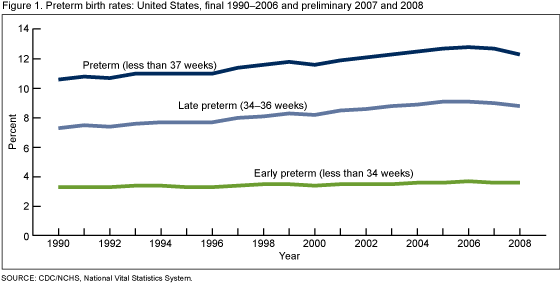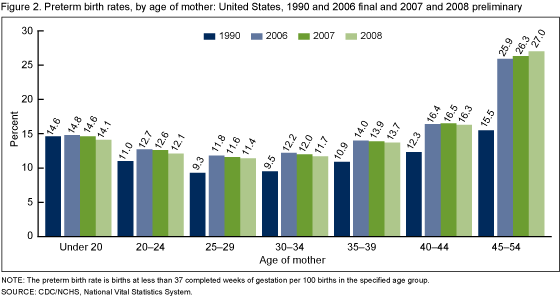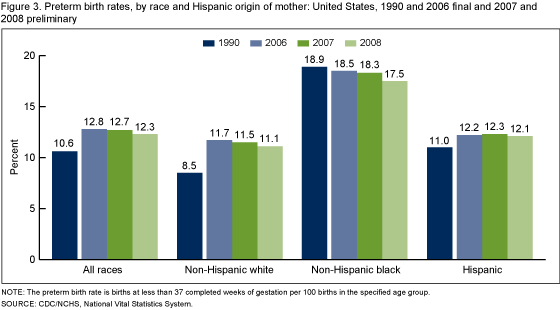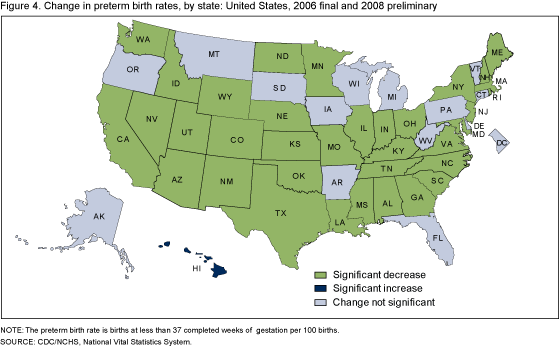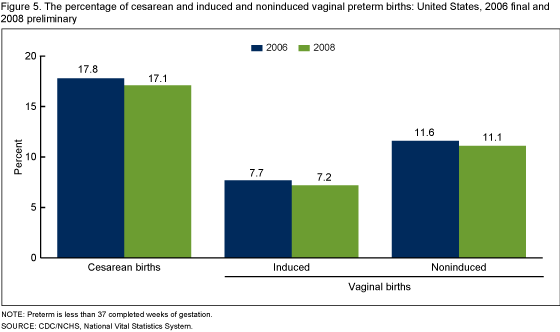Are Preterm Births on the Decline in the United States? Recent Data From the National Vital Statistics System
On This Page
- Key findings
- The U.S. preterm rate declines for the second straight year―the first 2-year decline in nearly three decades.
- Preterm births are down for women of all age groups under age 40.
- From 2006 to 2008, preterm birth rates dropped 5 percent among non-Hispanic white and non-Hispanic black infants.
- Preterm birth rates decline in most U.S. states.
- Preterm births are less likely among all types of deliveries.
- Summary
- Definitions
- Data source and methods
- About the authors
- References
- Suggested citation
NCHS Data Brief No. 39, May 2010
PDF Version (1.1 MB)
Joyce A. Martin, M.P.H.; Michelle J.K. Osterman, M.H.S.; and Paul D. Sutton, Ph.D.
Key findings
- Following a long period of fairly steady increase, the U.S. preterm birth rate declined for the second straight year in 2008 to 12.3 percent, from 12.8 percent in 2006.
- This marks the first 2-year decline in the preterm birth rate in nearly three decades.
- Preterm birth rates declined from 2006 to 2008 for mothers of all age groups under age 40, for the three largest race and Hispanic origin groups and for most U.S. states.
- The percentage of preterm births was down for all types of deliveries from 2006 to 2008, for cesareans and for induced and noninduced vaginal deliveries.
The U.S. preterm birth rate (less than 37 weeks of gestation) rose by more than one-third from the early 1980s through 2006 (1). This rise has been a cause of great concern (2,3). Preterm infants are at increased risk of life-long disability and early death compared with infants born later in pregnancy (2,4).
Many reasons, such as changes in maternal demographics and increases in multiple births, have been suggested for the growth in preterm births (5). Another factor cited is the heightened use of obstetric interventions such as induction of labor and cesarean delivery earlier in pregnancy (5,6,7). Although it is not possible to know whether an infant would be born preterm if labor was not induced or delivered by cesarean, studies suggest that increased use of these procedures before 37 completed weeks of gestation may have influenced the upswing in preterm birth rates (6,7).
Preliminary 2007 and 2008 birth certificate data reveal a shift in the long upward trend in preterm births (8,9). This report describes this change.
Keywords: preterm, late preterm, state-specific preterm birth rate
The U.S. preterm rate declines for the second straight year―the first 2-year decline in nearly three decades.
- The U.S. preterm birth rate declined for the second straight year in 2008, to 12.3 percent of all births, down 3 percent from 2007 (12.7 percent) and 4 percent from 2006 (12.8) (Figure 1).
- The preterm rate had been generally climbing since 1981, rising 13 percent from 1981 (the earliest year for which comparable data are available) to 1990 and more than 20 percent for the more recent period, 1990 to 2006 (1).
- The percentage of infants born late preterm (34 to 36 weeks of gestation) declined 3 percent, from 9.1 percent in 2006 to 8.8 percent in 2008; the late preterm birth rate had risen 25 percent between 1990 (7.3 percent) and 2006. Although at less risk than infants born before 34 weeks, late preterm infants are more likely to experience long-term neurodevelopmental problems and to die within the first year of life than infants born at term (2,4).
- The percentage of newborns delivered early preterm (less than 34 weeks of gestation) was also down in 2008, to 3.6 percent, compared with 3.7 percent in 2006. This level had risen from 3.3 percent in 1990. Infants delivered early preterm are much more likely to suffer long-term disability and early death than those born after 34 weeks (2,4).
Preterm births are down for women of all age groups under age 40.
- Preterm rates were lower for births to women of all age groups under age 40 years in 2008 compared with 2006 (Figure 2). Rates declined by 3 to 5 percent among births to women under age 35 years, and by 2 percent for women 35–39 years. Changes for age groups 40–44 and 45–54 years were not statistically significant.
- From 1990 to 2006, preterm rates had been on the rise among women of all age groups.
From 2006 to 2008, preterm birth rates dropped 5 percent among non-Hispanic white and non-Hispanic black infants.
- The 2008 preterm rate for non-Hispanic white infants was 11.1 percent, 3 percent lower than 2007 (11.5 percent) and 5 percent lower than 2006 (11.7 percent) (Figure 3). Preterm births among non-Hispanic white infants had climbed 38 percent from 1990 to 2006 (from 8.5 percent).
- The preterm birth rate for non-Hispanic black newborns declined to 17.5 percent in 2008, down 5 percent from 2006 (18.5 percent), and among the lowest levels ever reported (rates of 17.4 and 17.5 percent were previously reported) (Figure 3). Preterm rates for non-Hispanic black infants had trended downward during much of the 1990s, but rose between 2000 and 2006.
- The preterm birth rate for Hispanic infants declined from 12.3 to 12.1 percent from 2007 to 2008. This reduction follows a small increase between 2006 and 2007. Preterm rates among Hispanic infants fluctuated from 1990 to 2007, but rose by a total of 12 percent over this period (from 11.0 percent in 1990).
Preterm birth rates decline in most U.S. states.
- Since 2006 when the national rate peaked, preterm birth rates have declined significantly in 35 states (Figure 4). Only one state, Hawaii, reported an increase in preterm births.
- Before the recent downward trend, rates had increased significantly in all 50 states from 1990 to 2006. The only exception to this trend was the District of Columbia, for which the rate declined. (Preliminary 2008 preterm and late preterm state-specific birth rates [PDF – 82 KB]).
Preterm births are less likely among all types of deliveries.
- Preliminary 2008 data reveal that the percentage of all cesarean births that were preterm declined 4 percent from 2006 to 2008, from 17.8 to 17.1 percent.
- The percentage of induced vaginal births born preterm also decreased over this period, from 7.7 to 7.2 percent, as did the percentage of noninduced vaginal births, down from 11.6 to 11.1 percent (Figure 5).
Summary
Following a long period of fairly steady increase, the U.S. preterm birth rate declined in 2007 (from 12.8 to 12.7 percent), and then again in 2008 (to 12.3 percent), marking the first 2-year downturn in this rate in nearly three decades. Declines in preterm birth rates from 2006 to 2008 were observed for mothers of all age groups under age 40, for the three largest race and Hispanic origin groups, for the majority of all states, and for all types of deliveries.
The reduction in the overall preterm birth rate is not explained by changes in the proportions of multiple births (multiples are at much greater risk than singletons of preterm delivery). Preterm rates among singleton births declined by a similar amount as for all births over this period (from 11.1 to 10.6 percent.)
Previous research has suggested that increases in preterm induction of labor and cesarean delivery contributed to the rise in the overall preterm birth rate (6,7). Decreases in the use of these procedures before 37 weeks could also potentially reduce this rate. This report finds that the decline in the overall preterm rate from 2006 to 2008 was related to declines in all types of delivery, that is, in preterm cesarean and induced and noninduced vaginal births.
Although lower in 2008, the U.S. preterm birth rate remains higher than in any year from 1981 to 2002, with large differences still evident by race and Hispanic origin. Further research is necessary to explain the factors behind the current downturn and to develop approaches to help ensure its continued decline.
Definitions
Preterm birth rate: The number of births delivered at less than 37 completed weeks of gestation per 100 total births.
Late preterm birth rate: The number of births delivered at 34–36 completed weeks of gestation per 100 total births.
Early preterm birth rate: The number of births delivered at less than 34 completed weeks of gestation per 100 total births.
Multiple births: Births in twin and triplet and higher order multiple deliveries.
Cesarean: Extraction of the infant, placenta, and membranes through an incision in the maternal abdominal and uterine walls.
Vaginal: Delivery of the fetus through the vagina.
Induction of labor: Initiation of uterine contractions by medical or surgical means for the purpose of delivery before the spontaneous onset of labor (i.e., before labor has begun).
Data source and methods
This report contains data from the Natality Data File from the National Vital Statistics System. The vital statistics natality file includes information for all births occurring in the United States.
The natality files include information on a wide range of maternal and infant demographic and health characteristics for babies born in the United States. Final data may also be accessed from the interactive data access tool, VitalStats.
The primary measure used to determine gestational age is the interval between the first day of the mother’s last normal menstrual period (LMP) and the date of birth. The clinical or obstetric estimate of gestation is substituted where the LMP is missing or inconsistent with birthweight (1).
About the authors
Joyce A. Martin, Michelle J.K. Osterman, and Paul D. Sutton are with the Centers for Disease Control and Prevention’s National Center for Health Statistics, Division of Vital Statistics, Reproductive Statistics Branch. Brady Hamilton, Sharon Kirmeyer, and T.J. Mathews, also with the Reproductive Statistics Branch, provided helpful comments on this report.
References
- Martin JA, Hamilton BE, Sutton PD, et al. Births: Final data for 2006. National vital statistics reports; vol 57, no 7. Hyattsville, MD: National Center for Health Statistics. 2008.
- Behrman RE, Butler AS, ed. Preterm birth: causes, consequences, and prevention. Committee on understanding premature birth and assuring healthy outcomes, Board on Health Sciences Policy. Institute of Medicine. Nat’l Academies Press. 2005.
- March of Dimes. Prematurity Campaign 2008 Progress Report [PDF – 4.2 MB]. 2009.
- Mathews TJ, MacDorman MF. Infant mortality statistics from the 2006 period linked birth/infant death data set. National vital statistics reports; vol 58, no 17. Hyattsville, MD: National Center for Health Statistics. 2010.
- Engle WA, Kominiarek, MA. Late preterm infants, early term infants and timing of elective deliveries. Clinics in perinatol 35(2):325–41. 2008.
- Fuchs K, Wapner R. Elective cesarean section and induction and their impact on late preterm births. Clinics in perinatol 33(4):793–800. 2006.
- Bettegowda VR, Dias T, Davidoff MJ, et al. The relationship between cesarean delivery and gestational age among U.S. singleton births. Clinics in perinatol 35(2):309–23. 2008.
- Hamilton BE, Martin JA, Ventura SJ. Births: Preliminary data for 2007. National vital statistics reports; vol 57 no 12. Hyattsville, MD: National Center for Health Statistics. Online only release. March 18, 2009.
- Hamilton BE, Martin JA, Ventura SJ. Births: Preliminary data for 2008. National vital statistics reports; vol 58 no 16. Hyattsville, MD: National Center for Health Statistics. Online only release. April 6, 2010.
Suggested citation
Martin JA, Osterman MJK, Sutton PD. Are preterm births on the decline in the United States? Recent data from the National Vital Statistics System. NCHS data brief, no 39. Hyattsville, MD: National Center for Health Statistics. 2010.
Copyright information
All material appearing in this report is in the public domain and may be reproduced or copied without permission; citation as to source, however, is appreciated.
National Center for Health Statistics
Edward J. Sondik, Ph.D., Director
Jennifer H. Madans, Ph.D., Associate Director for Science
Division of Vital Statistics
Charles J. Rothwell, M.S., Director
- Page last reviewed: November 6, 2015
- Page last updated: May 11, 2010
- Content source:


 ShareCompartir
ShareCompartir
